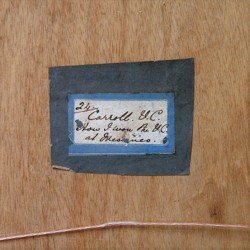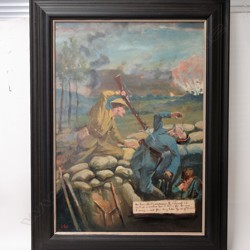JEWELLERY, ANTIQUE AND ART AUCTION Tuesday, 26 February 2019 - 10:00 AM start
Harry Royall
Lot Details
'How I won the VC at Massines (sic) Pte J Carroll VC', oil on paper, signed lower left Hy Royall, bears unique inscription written by Pte. John Carroll: 'How I won the VC at Massines (sic) Pte J Carroll VC, captured a machine gun & killing four Germans & saving a mate from being killed by one of Germans', bears label verso: '24 Carroll V.C. How I won the V.C. at Messines', 740 x 520 mm. Note: John Carroll (1891–1971) soldier, labourer and railway employee, was born in Brisbane. Carroll embarked for England in August 1916 with reinforcements for the 44 Battalion, then transferred to the 33 Battalion. On June 3rd, 1917 the Australian Division under Major General John Monash, including 33 Battalion, took part in the battle of Messines Ridge, a strategic and well-fortified position held by the Germans since 1914. Preparations for the Messines offensive had been done over a year earlier with the development of deep tunnels under the German lines which, by the time of the attack, housed over 930,000lbs of high explosive in over 20 enormous mines. The Australian Division was charged with the capture of the southern shoulder of Messines Ridge, the far right of the Allied push. At 3.10am on the morning of 7 June, 19 of the mines were detonated, virtually destroying the ridge and much of the German front line, accompanied by a creeping barrage of heavy artillery followed closely by the Australian infantry troops. Historian Charles Been wrote that following the detonation of the mines ‘… the only point at which resistance worthy of the name had been felt was… on the extreme right.’ Unlike other units in the Allied offensive pushing through and initially shocked and demoralised German front line, sections of the 33 Battalion met spirited resistance as it moved forward on the extreme right flank. Carroll immediately rushed the enemy trenches. For his actions Carroll was awarded the Victoria Cross. The recommendation for the award reads: ‘For most conspicuous gallantry and devotion to duty. In the battle of Messines Ridge on June 7 Pte. John Carroll Acted as a mopper-up. Immediately the barrage lifted he rushed the enemies’ trench and bayoneted four Germans. He then noticed a comrade in difficulties with one of the enemy and he at once proceeded to his comrade’s assistance and killed the German. He continued working ahead with grim determination and wonderful fearlessness and came across a machine gun and team of four men in a shell hole; they offered resistance but single-handed he attacked the entire team, killed them all and captured of the gun. Later two of his comrades were buried by a shell, in the spite of very heavy shelling and machine gun fire he extricated them. During the 96 hours the battalion was in the line Pte. Carroll displayed most wonderful courage and fearlessness. Each night he went out wiring in front of the new line ended excellent work. On two occasions he brought wounded men back to our line. His magnificent example inspired the whole battalion. Caroll who was known among his A.I.F. comrades as ‘The Wild Irishman’ was casual and happy go lucky by nature. He missed three dates for his investiture of the V.C. and had to be sent for on the fourth occasion. After the ceremony he amused himself by exercising the Victoria Cross winners' right to turn out the Buckingham Palace guard. He was also known as ‘Referendum Caroll’ because he really said anything but 'Yes' or 'No'. In 1956, Carroll was a member of the Australian contingent for the V.C. Centenary celebrations in London. He died on 4 October 1971 and was buried at Karrakatta Cemetery in Perth with full military honours. His Victoria Cross is displayed at the Australian War Memorial in Canberra.




